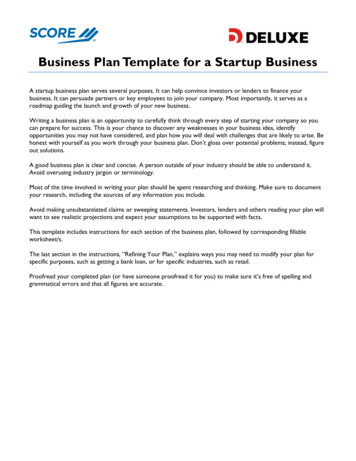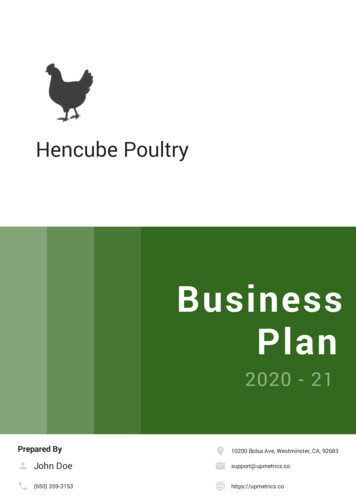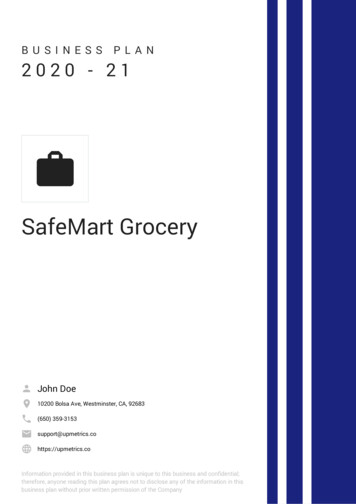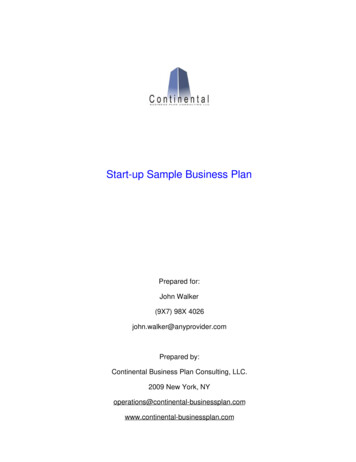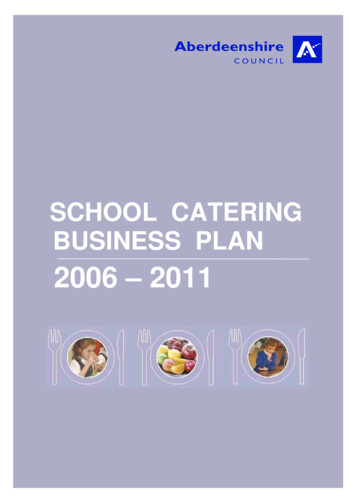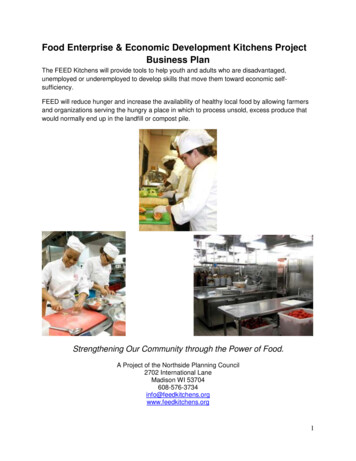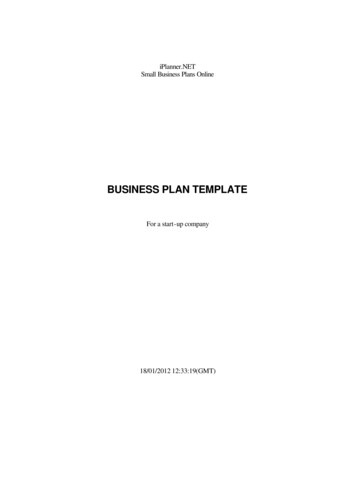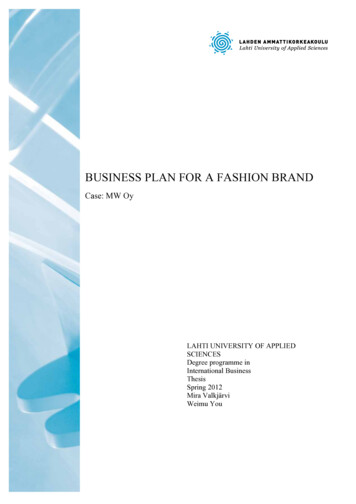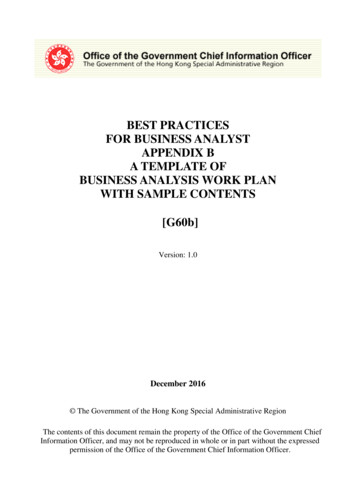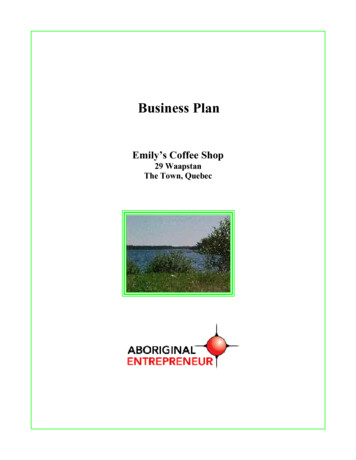
Transcription
Business PlanEmily’s Coffee Shop29 WaapstanThe Town, Quebec
Table of ContentsSummary . . . . . . . . . . . . . . . . . . . . . . . . . . . . . . . . . . . . . . . . . . . . . . . . . . . . . . . . . . . . . . . . . . . . 4Description of Business and Industry . . . . . . . . . . . . . . . . . . . . . . . . . . . . . . . . . . . . . . . . . . . . . . 4Business Products . . . . . . . . . . . . . . . . . . . . . . . . . . . . . . . . . . . . . . . . . . . . . . . . . . . . . . . 4Business Description . . . . . . . . . . . . . . . . . . . . . . . . . . . . . . . . . . . . . . . . . . . . . . . . . . . . . 5The Industry . . . . . . . . . . . . . . . . . . . . . . . . . . . . . . . . . . . . . . . . . . . . . . . . . . . . . . . . . . . . 5The Community . . . . . . . . . . . . . . . . . . . . . . . . . . . . . . . . . . . . . . . . . . . . . . . . . . . . . . . . . . . . . . . 6The Project . . . . . . . . . . . . . . . . . . . . . . . . . . . . . . . . . . . . . . . . . . . . . . . . . . . . . . . . . . . . . . . . . . . 8Objectives . . . . . . . . . . . . . . . . . . . . . . . . . . . . . . . . . . . . . . . . . . . . . . . . . . . . . . . . . . . . . 9Approach . . . . . . . . . . . . . . . . . . . . . . . . . . . . . . . . . . . . . . . . . . . . . . . . . . . . . . . . . . . . . . 9Financing . . . . . . . . . . . . . . . . . . . . . . . . . . . . . . . . . . . . . . . . . . . . . . . . . . . . . . . . . . . . . . 9Timing . . . . . . . . . . . . . . . . . . . . . . . . . . . . . . . . . . . . . . . . . . . . . . . . . . . . . . . . . . . . . . . . 9Long Range Plans . . . . . . . . . . . . . . . . . . . . . . . . . . . . . . . . . . . . . . . . . . . . . . . . . . . . . . . 9Two Year Plan . . . . . . . . . . . . . . . . . . . . . . . . . . . . . . . . . . . . . . . . . . . . . . . . . . . . 9Five Year Plan . . . . . . . . . . . . . . . . . . . . . . . . . . . . . . . . . . . . . . . . . . . . . . . . . . . . 9Ten Year Plan . . . . . . . . . . . . . . . . . . . . . . . . . . . . . . . . . . . . . . . . . . . . . . . . . . . . 9Socio-Economic Benefits . . . . . . . . . . . . . . . . . . . . . . . . . . . . . . . . . . . . . . . . . . . . . . . . . 10Marketing . . . . . . . . . . . . . . . . . . . . . . . . . . . . . . . . . . . . . . . . . . . . . . . . . . . . . . . . . . . . . . . . . . . 10Market Analysis . . . . . . . . . . . . . . . . . . . . . . . . . . . . . . . . . . . . . . . . . . . . . . . . . . . . . . . . 10Market Size . . . . . . . . . . . . . . . . . . . . . . . . . . . . . . . . . . . . . . . . . . . . . . . . . . . . . 10Market Share . . . . . . . . . . . . . . . . . . . . . . . . . . . . . . . . . . . . . . . . . . . . . . . . . . . . 11Location . . . . . . . . . . . . . . . . . . . . . . . . . . . . . . . . . . . . . . . . . . . . . . . . . . . . . . . . . . . . . . 11Target Market . . . . . . . . . . . . . . . . . . . . . . . . . . . . . . . . . . . . . . . . . . . . . . . . . . . . . . . . . . 11Best Market . . . . . . . . . . . . . . . . . . . . . . . . . . . . . . . . . . . . . . . . . . . . . . . . . . . . . 11Secondary Market . . . . . . . . . . . . . . . . . . . . . . . . . . . . . . . . . . . . . . . . . . . . . . . . 11Other . . . . . . . . . . . . . . . . . . . . . . . . . . . . . . . . . . . . . . . . . . . . . . . . . . . . . . . . . . 11Customers . . . . . . . . . . . . . . . . . . . . . . . . . . . . . . . . . . . . . . . . . . . . . . . . . . . . . . . . . . . . 11Competition . . . . . . . . . . . . . . . . . . . . . . . . . . . . . . . . . . . . . . . . . . . . . . . . . . . . . . . . . . . 12Strengths of the Product . . . . . . . . . . . . . . . . . . . . . . . . . . . . . . . . . . . . . . . . . . . . 12Weakness . . . . . . . . . . . . . . . . . . . . . . . . . . . . . . . . . . . . . . . . . . . . . . . . . . . . . . . 12Price . . . . . . . . . . . . . . . . . . . . . . . . . . . . . . . . . . . . . . . . . . . . . . . . . . . . . . . . . . . . . . . . . 12Credit . . . . . . . . . . . . . . . . . . . . . . . . . . . . . . . . . . . . . . . . . . . . . . . . . . . . . . . . . . . . . . . . 12Promotion . . . . . . . . . . . . . . . . . . . . . . . . . . . . . . . . . . . . . . . . . . . . . . . . . . . . . . . . . . . . . 13Operations Plan . . . . . . . . . . . . . . . . . . . . . . . . . . . . . . . . . . . . . . . . . . . . . . . . . . . . . . . . . . . . . . 13Description of Premises . . . . . . . . . . . . . . . . . . . . . . . . . . . . . . . . . . . . . . . . . . . . . . . . . . 13Production Plan . . . . . . . . . . . . . . . . . . . . . . . . . . . . . . . . . . . . . . . . . . . . . . . . . . . . . . . . 13Building Description . . . . . . . . . . . . . . . . . . . . . . . . . . . . . . . . . . . . . . . . . . . . . . 14Equipment . . . . . . . . . . . . . . . . . . . . . . . . . . . . . . . . . . . . . . . . . . . . . . . . . . . . . . 14Environmental Considerations . . . . . . . . . . . . . . . . . . . . . . . . . . . . . . . . . . . . . . . . . . . . . 15Risk Assessment of Operations Plan . . . . . . . . . . . . . . . . . . . . . . . . . . . . . . . . . . . . . . . . 15Management Plan . . . . . . . . . . . . . . . . . . . . . . . . . . . . . . . . . . . . . . . . . . . . . . . . . . . . . . . 15
Staffing Plan . . . . . . . . . . . . . . . . . . . . . . . . . . . . . . . . . . . . . . . . . . . . . . . . . . . . . 15Professional Services and Support . . . . . . . . . . . . . . . . . . . . . . . . . . . . . . . . . . . . 16Financial Plan . . . . . . . . . . . . . . . . . . . . . . . . . . . . . . . . . . . . . . . . . . . . . . . . . . . . . . . . . . . . . . . . 16Sources of Financing . . . . . . . . . . . . . . . . . . . . . . . . . . . . . . . . . . . . . . . . . . . . . . . . . . . 17Cost Overruns . . . . . . . . . . . . . . . . . . . . . . . . . . . . . . . . . . . . . . . . . . . . . . . . . . . 17Cash from Ongoing Operations . . . . . . . . . . . . . . . . . . . . . . . . . . . . . . . . . . . . . . 17Bridge Financing . . . . . . . . . . . . . . . . . . . . . . . . . . . . . . . . . . . . . . . . . . . . . . . . . 17Income Statement for 1997/98 . . . . . . . . . . . . . . . . . . . . . . . . . . . . . . . . . . . . . . . . . . . . . 18Income Statements 3 Year . . . . . . . . . . . . . . . . . . . . . . . . . . . . . . . . . . . . . . . . . . . . . . . . 19Projected 1 Year Cash Flow . . . . . . . . . . . . . . . . . . . . . . . . . . . . . . . . . . . . . . . . . . . . . . . 20Balance Sheet . . . . . . . . . . . . . . . . . . . . . . . . . . . . . . . . . . . . . . . . . . . . . . . . . . . . . . . . . . 22
Donut & Coffee ShopBusiness PlanSummaryEmily’s Coffee Shop is a new business that proposes to open in The Town, Quebec. It will be ownedby Emily Wapachee a member of the Cree First Nation of The Town.Emily’s Coffee Shop will be a new business that will sell coffee, donuts, soup and sandwichessimilar to a Tim Horton’s Franchise. Franchising was explored but at this time franchisers arelooking for higher population basis for this industry.The business will emphasize quality products at competitive prices and will promote the businessthrough the usage of signs and flyers. The customer base will be mostly Cree. They will come fromThe Town and other communities during sports and cultural tournaments.Emily Wapachee will work full time in the business and will employ an additional four full timepositions. These persons will be aboriginal, and Emily and her husband Matthew Wapachee willperform all management functions including record keeping. Emily has worked in the fast foodrestaurant business and has also passed a forty week baking course. She presently does weddingcakes for the community.Emily’s Coffee Shop will be seeking funding for the amount of 212,000.000. This will be raisedby applying for grants from INAC and loans from the The Town Economic Development, and theCree Business Center.The total revenues in year one will be 200,000.00 with a net profit of 17,000.00. The ratios arecomparable to industry standards and the community has demonstrated that it can support a businessof this type.Description of Business and IndustryEmily’s Coffee Shop will provide inexpensive, fast meals to office workers and members of thecommunity. Donut shops are very popular with Cree people who like to get together in communitytype settings.Customers will purchase from Emily’s Coffee Shop because the business will provide speedydelivery, excellent customer service, and superior quality food.Business DescriptionEmily’s Coffee Shop was chosen as a name because it describes the featured product of the businessand also identifies the nature of the business.The business will be owned by Emily Wapachee who is an aboriginal members of the Cree FirstAboriginal EntrepreneurPage 4
Donut & Coffee ShopBusiness PlanNation of The Town. Emily is starting her first business and has never received funding from anyaboriginal business program and the business has no close links to any existing business.The mailing address of the business will be Emily’s Coffee Shop, The Town, Quebec G0W 1C0.Phone (418) 923-3596.The start up date of the business will be the fall of 2000.The IndustryThe Donut/Coffee Shop industry continues its growth in Canada. The franchised units such asDunkin Donuts and Tim Hortons are expecting to add over 400 Donut shops in the next year inCanada.The main challenges of the Industry come from easily prepared meals that can be purchased in theconventional food stores. The convenience is equal to going out and the taste is roughly equal toprepared food from restaurants.Food Service continues to lead other industries in total sales such as housing, automaking, andelectronics. The food industry continues to gain a greater share of all food dollars spent in America,moving up to 45 percent versus 55 percent for retail food which represents a gain of 20 share pointssince 1960. As these figures show, there is room for entry into the restaurant marketplace.The eateries that succeed are the ones that offer midpriced meals and are perceived by the customeras offering price value entrees.The key factors to success in this industry are quality, cleanliness and perceived cleanliness of thefacility, speed of service, and superior customer service (friendliness).The CommunityThe Town is the second largest community in the Region and it is readily accessible year round.Connected to the Québec highway system via the The Town urban centre 120 km. away, The Townhas access to the north by way of the Route connecting to the Highway through NTown. The airportat The Town provides direct connections to Montreal and Québec City and the highway networkprovides easy access from the south.Lake Mistassini and the surrounding lands are among the worlds most beautiful and pristine places.Its natural and cultural resources represent a vast array of attractions to tourists. The lands are mostlyReserves or Category I and II, meaning that the Cree exercise use and control over it. The Town isalso one of the few Cree Communities with a well developed Tourism Strategic Plan.Aboriginal EntrepreneurPage 5
Donut & Coffee ShopBusiness PlanThe Town Area ProfileA. LocationThe Town is the second largest Cree community with a population of around 2,400 Cree and 150nonnatives. It is situated at the southern end of a lake. The The Town Community, its reserve andits category I and II lands are virtually surrounded by the large National Assinica Albanel / Mistassiniand Wasconichi Wildlife Reserves. It is approximately 90 km from the Chibougamau municipalityand 120 km from the airport with connections to Montreal, Quebec City, Nemaska and Waskaganishas well as to the rest of the region.The Cree populations in all of the communities are growing and are forecasted to continue to exceednational averages for years to come. Also, the populations are youthful with over 55% under age 25.This represents a continuing demand for new housing and expanded infrastructure as new familiesare formed.Community19941996% he 9489data .11WaskaganishTotalsThere are other positive economic development indicators. For example, recently it was announcedthat a year round road will be built connecting the James Bay Highway to Waskaganish. At presentthere is only a winter road which will be replaced with either a year round gravel road or possiblywith a paved road. This will be a road of around 100 km and will provide considerable workopportunities over the next couple of years.Entrepreneurship is also on the rise and there is now a steady stream of new business formation inthe retail, service and tourism sectors.Aboriginal EntrepreneurPage 6
Donut & Coffee ShopBusiness PlanB. Access and TransportationAccess to and into the The Town area is available through a variety of methods. The community ofThe Town is accessible by highway 167, a class 2 gravel road to Chibougamau, 90 km away. Thisroad continues to the Chalifour River and Albanel Lake, with secondary roads leading to WaconichiLake and to other entrances to the Wildlife Reserves. From Chibougamau, the Route du Nord passesthrough the Assinica Reserve en route to Nemaska.The Chibougamau airport is some 105 km distant and The Town has a facility to land float planes.There are various water and portage corridors and in the winter snowmobile trails provide access.Local operators include Air Creebec and other charter aircraft and helicopter services. Connectionscan be made using various taxi, mini bus and other large and small vehicles on a hire, charter orrental basis. More comprehensive services of this nature are available on a regional basis such as inChibougamau and Chapais.C. Accommodation and Hospitality ResourcesAccommodation available to travellers and tourist and to support Native Adventures inc
Dunkin Donuts and Tim Hortons are expecting to add over 400 Donut shops in the next year in Canada. The main challenges of the Industry come from easily prepared meals that can be purchased in the conventional food stores. The convenience is equal to going out and the taste is roughly equal to prepared food from restaurants.
